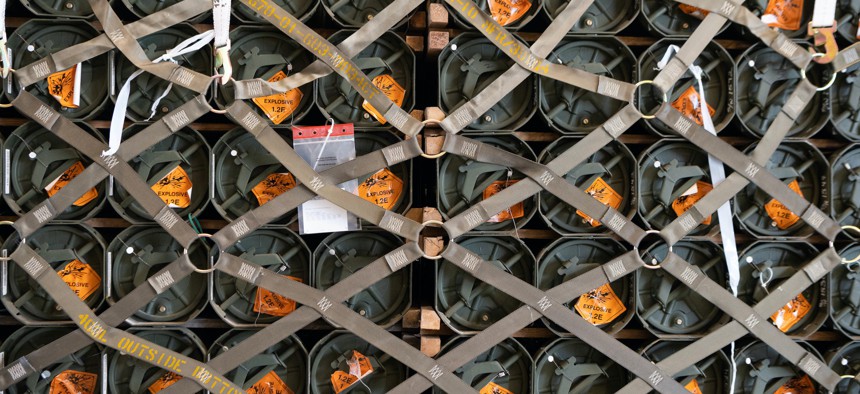
Pallets of ammunition, weapons and other equipment bound for Ukraine are processed through the 436th Aerial Port Squadron during a foreign military sales mission at Dover Air Force Base, Delaware, Jan. 21, 2022. U.S. Air Force / Mauricio Campino
Pentagon, Industry Leaders Meet to Talk Replenishing Military Weapons Stockpiles
Top-level Pentagon meeting comes as the U.S. prepares to send more sophisticated and lethal weapons to Ukraine.
Pentagon officials are talking to the leaders of America’s largest defense firms about ways to replenish the U.S. military’s weapon stockpiles, which are being raided to assist Ukrainian forces.
As the U.S moves to send Ukraine more sophisticated and more lethal weaponry, Deputy Defense Secretary Kathleen Hicks met with defense CEOs at the Pentagon on Wednesday to figure out how quickly companies could resupply these arms.
“We wanted to make sure that we had a good, honest, candid discussion with these CEOs, about the systems that they're producing, about the rate at which they're being produced, about the possibility for accelerating some of those production lines and expanding them, based on the heavy draw on our inventory to support Ukraine,” Pentagon Press Secretary John Kirby said at a Wednesday briefing.
The Pentagon has been raiding its weapon stockpiles to send anti-tank and anti-aircraft weapons to Ukrainian forces trying to fend off a Russian invasion for nearly two months. The Biden administration on Wednesday announced a new $800 million weapons package for Ukraine that includes howitzers, helicopters, drones, and uncrewed coastal defense vessels.
The weapons, like previous arms transfers to Ukraine, have come from U.S. and ally stockpiles. In most cases, these weapons take months, if not years, to replace, which has prompted U.S. officials to begin discussions with companies about production capacity and lead time needed to resupply stockpiles.
“I want to stress that we have not reached the level of inventory of any of these systems that are impacting our readiness abilities,” Kirby said. “But we don't want to get to that point before we start to have a conversation with industry about replenishment and the production line going forward.”
The U.S. raided its bomb stockpiles around the word during the airstrike campaign against ISIS in Iraq and Syria. That prompted concern from top military officials and Congress.
Lawmakers last month approved billions of dollars to replenish U.S. weapons being sent to Ukraine.
Pentagon officials played down Wednesday’s meeting as a regular dialog between defense officials and business leaders. It’s the second time in three months that Hicks has met with industry executives—she previously met with the heads of large and startup firms working on hypersonic weapon projects, in late January. While these get-togethers are starting to become routine, historically, it’s rare for groups of CEOs from the large defense firms to meet with senior Pentagon leaders.
Boeing, L3Harris Technologies, Raytheon Technologies, BAE Systems, Lockheed Martin, Huntington Ingalls, General Dynamics, and Northrop Grumman attended, Kirby said.
“We were very grateful … for their willingness to come on in and have this discussion,” he said. “I would fully expect that there'll be additional such roundtable discussions going forward with these CEOs, and perhaps others as time goes on.”
